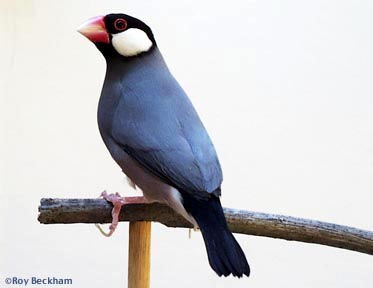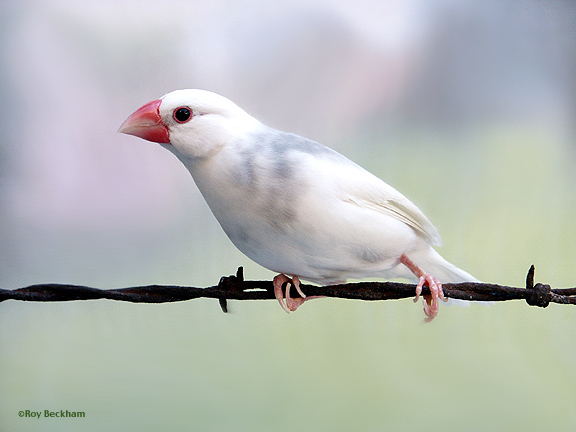|
Common Names
Java Rice Bird, Java Temple Bird, Paddy Bird
Description
Java Sparrows are large, full-bodied finches. Measuring over 5-1/2" long. They have impressive beaks that look like they could do some serious damage, however, they are harmless. Males and females are nearly identical in appearance. There are a number of ways to distinguish between the sexes. Like most members of the Lonchura family, the males sing and perform a little dance. The dance is not much to see and many don't think much about the song, but I find it a pleasant, tropical sounding song. Unlike most mannikins, you can actually hear it for some distance. Waiting for them to sing can be a test of patience however. (MP3 of a Java song)
A better way to sex Javas is with a couple of visual clues. These differences are better seen in a large group of birds rather than looking at one pair. On a male in breeding condition, the culmen (the top of the beak, especially where it meets the head) has an apparent swelling. A definite ridge will form and the color will turn a deeper red on the males. It is said that the eye ring turns a richer red as well, but I find the beak easier to see.
Despite their large size and formidable beak, Javas are peaceful birds. They will get along well with smaller finches in a mixed aviary setting. The ones they will bicker with are themselves. Get a group of them together and there will be a lot of bill fencing and squabbling noises, but they rarely do this with other finches. I have never kept them with the smallest of waxbills, but I don't think they would cause them any harm either. I also kept them with the little Rufous-Back Mannikin and that pugnacious little bird held his own against the Javas.
Diet
The Java Sparrows diet begins with a basic parakeet seed mix. You can use a standard finch mix, but these often contain a number of smaller millets that the Javas will ignore until the last large white millet is gone. You can also offer them just plain White Prosso and any other seeds in a separate dish. Javas will often seek out the oats in a Parakeet mix and will sift through the seed until they find it all. In a gravity feeder, this means they will drain the entire supply and scatter the seed looking for the oats. It is best to offer them and they will eagerly take egg food (Roy's egg food mix), gamebird crumbles and green food. I have never seen them eat live food, but suppose they could be enticed to if you really insist (but why feed livefood if you don't have to). Calcium can be provided in the form of crushed egg shell, crushed oyster shells or cuttlebone, but they are not normally enthusiastic about the cuttlebone. Despite their name, they really don't eat a lot of Rice. I have offered them Paddy Rice like I do all my Mannikins and Munia, but they are not as enthusiastic about this seed as some of the other Lonchura. They do like the Paddy Rice in a sprouted form.
Breeder's Notes
Javas can be very prolific. This is part of the reason why they are banned in so many areas. They routinely have large clutches of 6-8 birds. They really do well with a clutch no larger than 5 though. They will use just about any size nest box. I've had them breed in small, standard 5"x5" nest boxes, but I prefer that they use a 8"x 8" nest box that is simply a larger version of my standard box. This may seem large at first when you see the hen stuffed into the corner of the box, but as the chicks grow, you'll see why the extra space is nice. For the most part, they are terrible nest builders using only coarse materials and shredded paper. Forget the soft feathers and burlap with these birds. The only feathers I've seen them use are large flight and tail feathers from my Mountain Quail. Hay, pine needles, coconut fiber and newspaper are their choices. Some will make use of the coco fiber and weave an intricate nest. As always, I put a handful of sawdust in the bottom of the box first, just in case the birds are minimalists and don't use anything.
The clutch will usually range from 4-8 eggs. Incubation starts somewhere after the 3rd or 4th egg and lasts for 13-15 days. The chicks are born in typical Lonchura fashion - pink and fuzzless. (Java approx 10 days). They will stay in the nest for a long time compared to most finches. It will be nearly a month before they fledge. Give the fledglings another 2-3 weeks to be weaned from their parents. The young are dusky gray versions of the adults. The beaks are also dark. They take several months to fully molt into their adult plumage.(Fledged Java still in juvenile plumage)
They'll breed just about anytime the weather is suitable. They'll avoid the hottest summer months and cold winter months if kept outside. Kept indoors under controlled conditions, they'll breed year-round. As with most birds, you're better off to hold that production to a few clutches per season, otherwise the Javas will just keep on going if you let them.
Additional Notes
As surprising as this may sound, the Java Sparrow is listed on the CITES (Convention on International Trade in Endangered Species of wild fauna and flora) appendix II. Apparently, even though the Java Sparrow is considered a pest in many areas because of the devastation they can cause to a rice crop, in Java they are becoming scarce. This really does not affect much in the US since the Java Sparrow is restricted from imports by the USFWS and they are readily available from domestically bred stock anyway.
Be sure to check the regulations in your area. The Java Sparrow is restricted in many parts of the US due to the fear that they may establish themselves in an agricultural area.
In addition to the Gray (wild) form, there is a Fawn, pied(see below) and white mutation of the Java available in the US. In Europe, there are dilute or silver varieties available as well. There is also an Agate form being established in many areas Again, due to the restrictions on imports, these cannot be brought into the US., however these forms are finding their way to US breeders.
|













